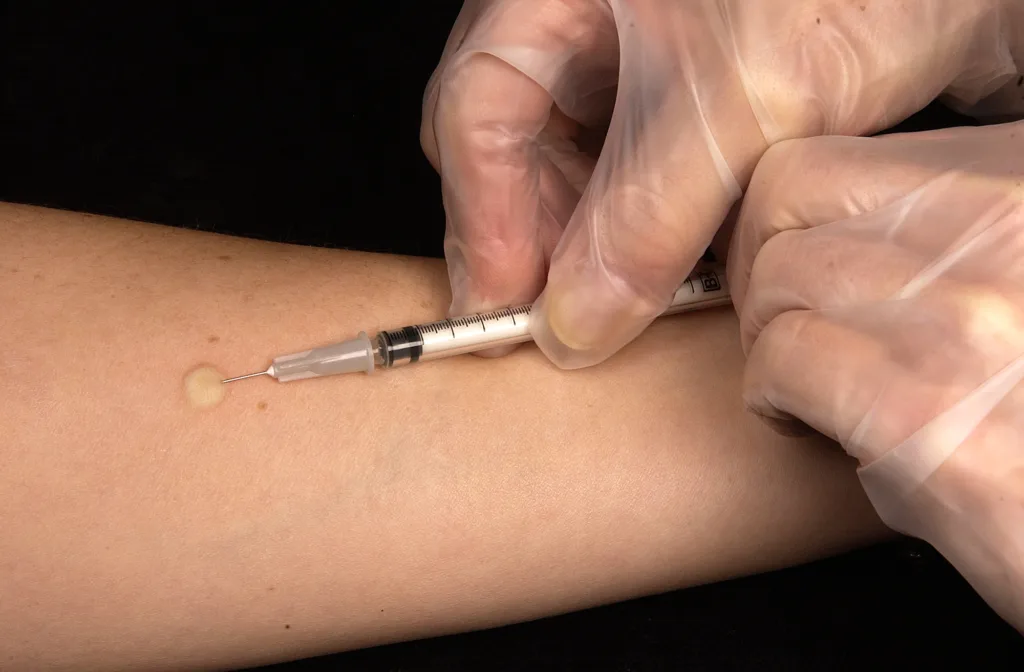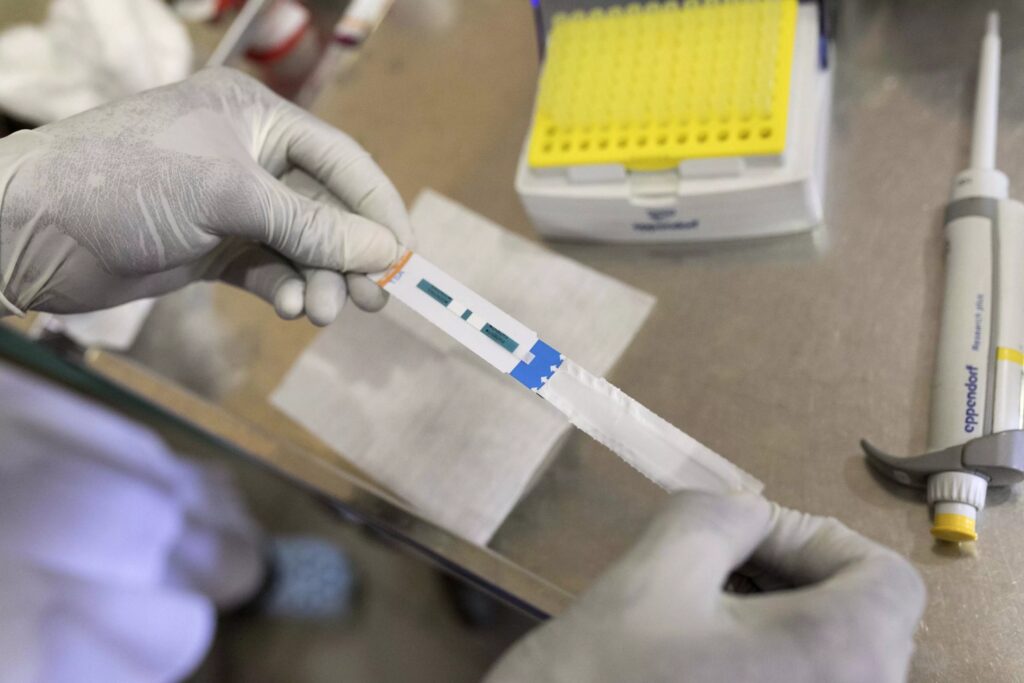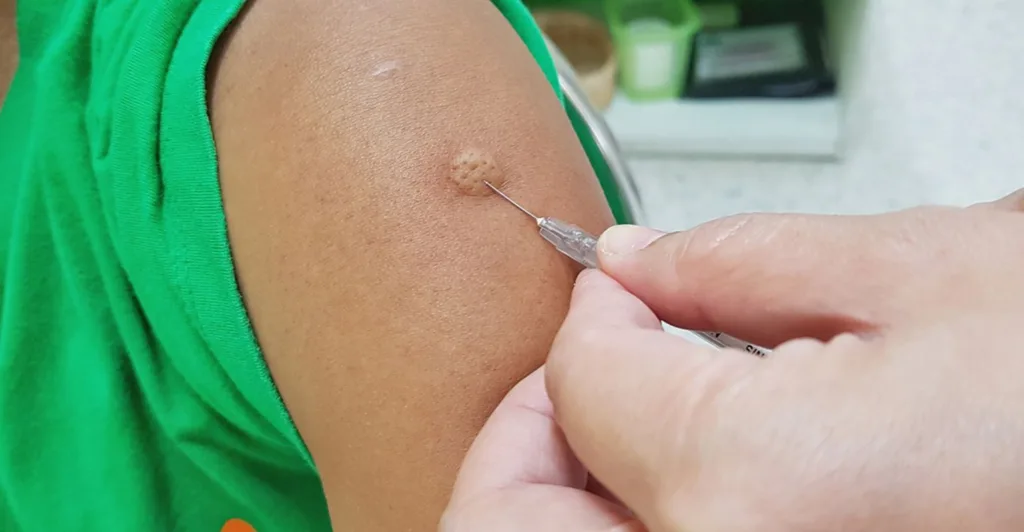Tuberculosis (TB) is a serious infectious disease that affects the lungs and can spread to other parts of the body. It is caused by a bacterium called Mycobacterium tuberculosis. TB is a highly contagious disease that spreads throgh the air when an infected person coughs, sneezes, or talks. It is important to get tested for TB if you have been exposed to someone with the disease or if you are at risk of infection.
One of the most common tests for TB is the tuberculin skin test, also known as the Mantoux test. This test is performed by injecting a small amount of fluid (tuberculin) into the skin on the lower part of the arm. The test is done to see if a person has been infected with the TB bacteria. After the injection, a person must return within 48 to 72 hours to have a trained health care worker check for a reaction on the arm.
So, does a TB test hurt? Well, the answer is that it depends on the individual’s pain tolerance. The injection site may cause a slight sting, but it is usually not painful. After the injection, a bump or small welt will form, which usually goes away in a few hours. However, a person who has been exposed to TB germs may occasionally have a sizable reaction, which may cause some mild itching, swelling or irritation. These kinds of reactions should disappear in one to two weeks.
It is important to note that there is a slight risk of having a severe reaction to the tuberculin skin test, especially if you have had TB in the past. An allergic reaction can cause a lot of swelling and pain at the site, and a sore may be present. However, severe reactions are rare.
The tuberculin skin test is a simple and painless way to check for TB infection. While there may be some mild discomfort or irritation at the injection site, severe reactions are uncommon. If you have been exposed to TB or are at risk of infection, it is important to get tested to ensure that you receive the appropriate treatment and prevent the spread of the disease.
The Effects of a TB Test on Arm Pain
It is possible to experience some discomfort or soreness at the site of the TB test. This is because a small needle is used to inject a small amount of tuberculin solution into the skin of your forearm. This process can cause a mild stinging or burning sensation, and the area may become slightly red or swollen. It is also not uncommon to experience some tenderness or soreness at the site of the injection for a few days afterwards. However, if you experience severe pain or swelling, or if the area becomes very red or develops a blister, it is important to seek medical attention as this could be a sign of a more seious reaction.

Expectations of a TB Test
A TB test, also known as a tuberculin skin test, involves injecting a small amount of fluid called tuberculin into the skin on the lower part of your arm. The test is usualy administered by a trained healthcare worker. After the injection, you will be asked to wait for 48 to 72 hours before returning to have your arm checked for a reaction. During this time, your body will react to the tuberculin, causing a small bump or swelling at the site of the injection. This is a normal response to the test and is not a sign of infection. If there is no reaction, it may mean that you have not been exposed to TB or that your immune system is not responding to the test. However, if you do have a reaction, it does not necessarily mean that you have active TB disease. Further testing may be needed to confirm a diagnosis. Overall, a TB test is a quick and relatively painless way to check for exposure to TB and is an important tool in preventing the spread of the disease.
Effects of a TB Test
After a TB test, you may feel a slight sting or pinch at the site of injection. A small bump or welt may also form, which usually goes away in a few hours. This reaction is normal and is a sign that the test is working as intended. However, if you experience severe pain, swelling, or redness at the injection site, or if you develop a fever, you should contact your healthcare provider right away.
After 48 to 72 hours, you must return to your doctor’s office to have the test site checked. A nurse or other medical professional will examine the area where you received the shot to see if you’ve had any reaction to the PPD. If the test is positive, it means that you have been infected with TB bacteria at some point in your life. However, a positive test does not necessarily mean that you have active tuberculosis. Further testing and evaluation may be necessary to determine whether you have active TB disease or latent TB infection.
Does a Tuberculosis Test Have Any Negative Side Effects?
No, the TB test itself does not make you feel sick. The Mantoux skin test, which is the most common type of TB test, involves injecting a small amount of fluid under the skin of your forearm. This fluid contains a protein that comes from the TB bacteria. If you have been exposed to TB, your body will react to this protein by producing a small bump, called a “wheal,” at the injection site.
While it is possible to experience some mild itching, swelling, or irritation at the injection site, these reactions are uncommon and typically disappear wihin one to two weeks. It is important to note that the skin test is not a live vaccine and cannot cause you to get sick with TB. In rare cases, a person may have an allergic reaction to the protein in the test fluid, but this is very uncommon.
If you have any concerns about the TB test or experience any unusual symptoms after the test, it is important to speak with your healthcare provider. However, in general, the TB test is a safe and relatively simple procedure that can help identify whether you have been exposed to TB bacteria.
Comparing the Pain of a TB Test and a Shot
TB test and shot are two different medical procedures that involve different types of injections and may cause different levels of discomfort or pain.
A TB test involves injecting a small amount of liquid called tuberculin under the skin of the forearm. This may cause a small bump or blister to form, and the area may become slightly red and itchy. However, the injection itself should not be very painful or uncomfortable. Most people describe it as a quick pinch or sting that lasts for a few seconds.
On the othr hand, a shot may refer to various types of injections, such as vaccines, medications, or fluids. The pain and discomfort of a shot may depend on several factors, including the type of injection, the location of the injection, the size of the needle, and the person’s pain tolerance. Some shots may cause mild pain or soreness at the injection site, while others may cause more intense pain or muscle stiffness.
In general, it is difficult to compare the pain of a TB test and a shot since they are different procedures with different objectives and effects. However, both procedures are usually quick and relatively painless, and any discomfort or pain should be brief and manageable. If you are concerned about pain or discomfort during a medical procedure, you can talk to your healthcare provider and ask for ways to reduce it, such as using a numbing cream or taking pain relievers.

Showering After a TB Test
Yes, you can shower rght after a TB test. A TB test involves a small injection of fluid under the skin of your arm, and it is important that you do not wash or bandage the injection site for at least 48 to 72 hours after the test. However, taking a shower or bath will not affect the results of the test or increase your risk of infection. It is important to avoid rubbing or scratching the injection site, as this can cause irritation or even make the test results inaccurate. If you have any concerns or questions about your TB test or its aftercare, you should talk to your healthcare provider for guidance.
Eating Before a TB Test
Yes, you can eat before a TB test. In fact, it is recommended that you have a healthy breakfast before your TB screening. However, it is important to avoid heavy, greasy or fatty foods as they can affect the accuracy of the blood test. It is also important to stay well-hydrated by drinking plenty of water throughout the day of your TB screening and in the days leading up to it. This will make it easier for the healthcare provider to draw your blood and ensure accurate results. If you have any concerns aout what to eat or drink before your TB test, it is best to consult with your healthcare provider for specific instructions.
Time Frame for TB Testing
A TB test, also known as a tuberculin skin test (TST), typically takes a few minutes to administer. The test involves injecting a small amount of fluid (tuberculin) just under the skin of the forearm. After the injection, the person must wait for 48 to 72 hours before the test reaction is read by a trained healthcare worker. Therefore, the entire process of a TB test may take up to 3 days. It is important to note that during this waiting period, the person shoud avoid touching or scratching the area where the injection was given. Overall, a TB test is a quick and simple procedure that can help diagnose tuberculosis infection.
Preparing for a TB Test
To prepare for a TB (Tuberculosis) test, there are a few thigs to keep in mind. First, it’s important to note that there are two types of TB tests: the skin test (also known as the Mantoux test) and the blood test (also known as the interferon-gamma release assay or IGRA).
For the skin test, there are no specific preparations needed. However, it is recommended to avoid any vaccines (such as the flu shot) at least two weeks before the test. Additionally, if you have had a positive TB test in the past, you may need to take a chest X-ray before taking the skin test.
For the blood test, there are also no specific preparations needed. However, it’s important to inform your healthcare provider of any medications you are taking, as some medications may affect the test results.
Overall, the most important thing to remember is to follow any instructions given by your healthcare provider and to inform them of any relevant medical history or medications you are taking.

Does a Tuberculosis Test Leave a Scar?
Yes, a TB test can leave a scar or mark on the skin. This is more likely to occur if the test result is abnormal, whch means that the person has a positive reaction to the test and may have TB infection. In such cases, the skin may become inflamed and red, and a hard bump may form at the site of the injection. Over time, this bump may subside, but it can leave behind a scar or mark on the skin. It’s important to note that not all abnormal TB test results result in scarring, and scarring can also occur with normal test results. The size and severity of the scar can vary depending on the individual’s skin type and the location of the injection. If you are concerned about scarring, it’s best to talk to your healthcare provider about ways to reduce the risk of scarring and minimize any potential scarring that may occur.
The Contagiousness of a TB Test
After havig a TB test, such as a PPD skin test, a positive result indicates that you have been infected with the TB bacteria at some point in your life. However, it does not necessarily mean that you have active TB disease or that you are contagious. To determine if you are contagious, you will need to undergo further testing, such as a chest x-ray and physical exam, to check for signs of active TB disease. If you are found to have active TB disease, you may be contagious and need to take precautions to avoid spreading the infection to others. However, most people with a positive TB skin test are not contagious and can continue their daily activities as usual. It’s important to follow up with your healthcare provider to discuss any concerns and determine the appropriate next steps.
Signs of a Positive TB Test
When you have a positive TB test, there are several signs that may be present. The most common sign is a raised, hard bump at the site of the injection. This bump is typically about the size of a pea, and it may be red or swollen. Additionally, you may experience some pain or discomfort at the site of the injection.
In some cases, a positive TB test may also cause other symptoms. For example, you may have a cough that lasts for more than thre weeks, chest pain, or difficulty breathing. You may also experience fatigue, fever, or night sweats.
It’s important to note that a positive TB test doesn’t necessarily mean that you have active tuberculosis disease. Instead, it simply means that TB germs are present in your body. Your healthcare provider will need to perform additional tests, such as a chest X-ray or sputum test, to determine if you have active TB disease or if you simply have latent TB infection.
What to Do If a TB Test Is Red but There Is No Bump
If your TB test site is red but there is no bump, it is unlikely that you have been infected with TB bacteria. However, it is important to note that a redness without a bump may also be caused by other factors such as an allergic reaction or previous exposure to the TB vaccine. It is recommended that you consult with a healthcare provider who can assess your individual situation and provide further guidance. In some cases, additional testing or monitoring may be necessary to determine the cause of the redness.

Source: poz.com
Amount of Blood Required for a Tuberculosis Test
For a TB test, also known as a QuantiFERON-TB Gold Plus test, 1 ml of blood is typically collected by venipuncture directly into each QFT blood collection tube. It is important to ensure that the tubes are at a temperature of 17-25°C at the time of blood filling to ensure optimal results. Following these procedures can help to ensure accurate and reliable test results.
Conclusion
In conclusion, the TB test, also known as the Mantoux skin test, is a simple and effective way to determine whether a person has been exposed to tuberculosis. It involves injecting a small amount of tuberculin into the skin on the lower arm and then checking for a reaction after 48 to 72 hours. While side effects such as swelling and itching are possible, they are usully mild and go away on their own within a few days. Overall, the TB test is a safe and reliable way to screen for TB and is an important tool in preventing the spread of this disease. If you have concerns about TB or have been exposed to someone with TB, talk to your healthcare provider about getting tested.
